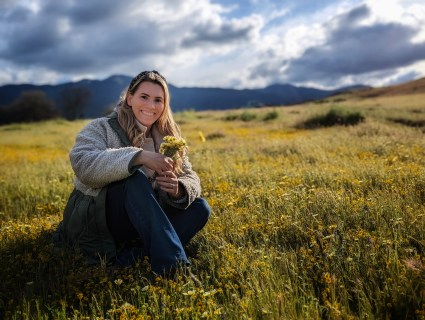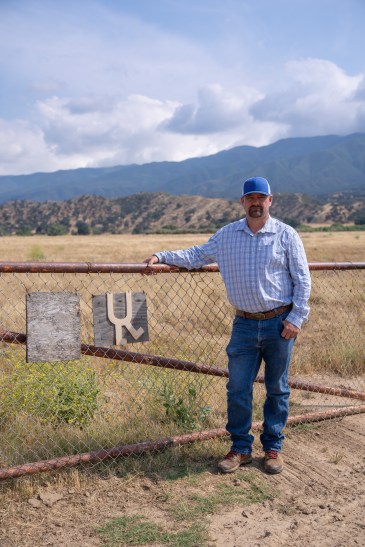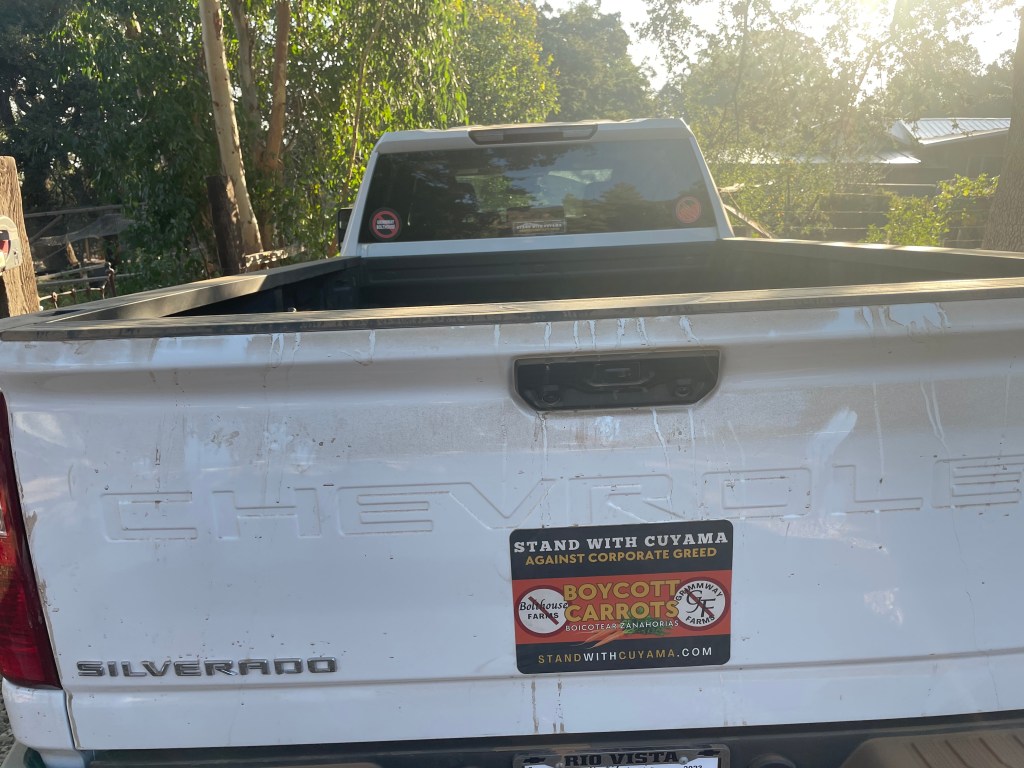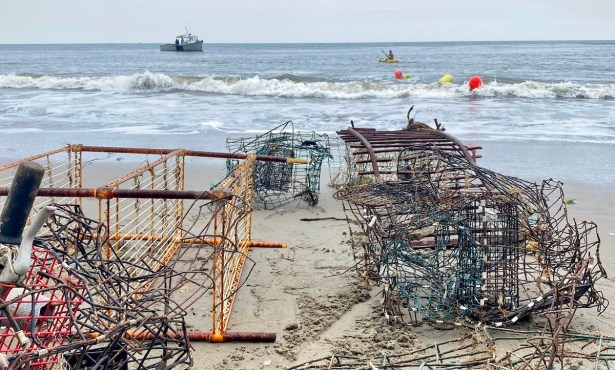The Cuyama Valley Launches
a Carrot Boycott
Farmers and Ranchers Take Aim
at Bolthouse and Grimmway
by Melinda Burns | September 29, 2023

The people of the Cuyama Valley, a vast land of little rain east of Santa Maria, have had enough.
Faced with mounting legal fees, they’ve kicked off a boycott against the carrot corporations in their midst, two global companies that are roping 700 valley landowners into an expensive water rights lawsuit.
It’s a tough proposition, taking on Bolthouse and Grimmway, the largest carrot producers in the world and by far the largest water users in the valley. But the stakes are high. Well water is the only source of water here, and underground water levels are in steep decline.
“I think the difficult thing for all of us to wrap our heads around is, we’ve never had corporations outwardly come straight out and attack us,” said Charlie Bosma, a retired Sheriff’s deputy who owns a cattle ranch and orchard near New Cuyama.
“They’ve been farming in this valley for decades and depleting the water table consistently as the biggest users of water,” Bosma said of Bolthouse and Grimmway. “We knew that. But we never expected they could do that type of damage to our water table and then turn around and sue us.
“We’re not going to be okay with this type of bullying.”
Bosma said he’s had to pay $11,700 in legal fees to defend his water rights to date. The lawsuit, which was filed in 2021 in Los Angeles Superior Court, has finally been set for an initial trial on January 8. Water rights “adjudications,” as such cases are called, can drag on for years.
Court records show that 30 law firms and government agencies are representing more than 90 valley landowners against Bolthouse and Grimmway, including cattle ranchers, dairy farmers and pistachio, apple, olive, vegetable, and grape growers. The legal fees paid by the landowners to date — including a small school district and the water districts for three small low-income communities — likely total many hundreds of thousands of dollars.
Santa Barbara County Supervisor Das Williams, who represents the Cuyama Valley, sent out a newsletter to his constituents, urging them to support the carrot boycott.
“It’s a way Cuyama residents are trying to reclaim their power, and I always encourage people to live their values through the pocketbook,” he said.

Feeling “Forgotten”
The boycott was launched in late July at a meeting with 150 residents at the Cuyama Buckhorn. Now the organizers, who are ranchers themselves, say they’re having trouble keeping up with the demand for boycott yard signs, bumper stickers and banners, which are posted prominently at ranch gates and along highways 166 and 33.
Bolthouse and Grimmway produce carrots of all shapes and sizes, including bunch carrots, snack-pack carrots, shredded carrots, crinkle-cut carrots, mini carrots, carrot juice, and carrot sticks. They created the wildly popular baby carrot market, beginning in the 1990s, triggering a massive expansion of carrot farming in the Cuyama Valley. Grimmway sells carrots under the Bunny-Luv and Cal-Organic brands.
The boycott is aimed at supermarket carrots, said Ella Boyajian, an organizer who owns a cattle ranch at the western end of the valley.

“If they’re in a supermarket, chances are they’re Bolthouse and Grimmway,” she said. “It’s best to buy carrots in a farmers’ market if you can.”
The campaign has a Facebook page and a website, StandWithCuyama.com, and claims to have collected more than 7,000 signatures on a petition — mostly from residents and their relatives — demanding that Bolthouse and Grimmway stop over-pumping, drop the water rights lawsuit and reimburse other landowners for the lawyers’ fees they have incurred.
This Saturday, the community is set to gather after the football homecoming game in New Cuyama to pose for a group photo with a StandWithCuyama banner.
“One of the things I hear is how forgotten people feel,” Boyajian said. “That lawsuit was a violation, almost, of the philosophy out here where people are good neighbors. “It was a real breach of that neighborliness and created this huge sense of frustration.”
A “Collaborative Process”?
The Cuyama Valley groundwater basin is immense, covering 380 square miles in four counties — Santa Barbara, Kern, San Luis Obispo, and Ventura — but it’s not infinite. For 75 years, farming operations — first, mainly alfalfa, and now, mainly carrots — have drawn down the underground supply. Today, Cuyama is on the state list of 21 basins in “critical overdraft.” The rest are in the Central Valley.
Bolthouse and Grimmway’s lawsuit follows on the heels of a mandatory 5 percent pumping reduction that went into effect in March. For now, the cutbacks are limited to the flat central area of the valley, where Bolthouse and Grimmway own or lease more than half the land, and where the underground water table is lowest.
The pumping reductions are slated to increase to 6.5 percent yearly in 2025. Under the state Sustainable Groundwater Management Act of 2014, the Cuyama basin must be back in balance by 2040.
“The government provided us a democratic process to deal with this,” Bosma, the retired Sheriff’s deputy, said. The lawsuit, he said, was “a battle none of us needed and none of us can afford.”

Representatives of Bolthouse and Grimmway helped draft the schedule of cutbacks as members of the Cuyama Basin Groundwater Sustainability Agency (GSA) board, made up of county officials and major landowners. By filing a lawsuit, they are now effectively asking a judge in Los Angeles to determine how much water each landowner in the valley is entitled to.
The Bolthouse Land Co., a subsidiary of Bolthouse Properties, is a plaintiff in the lawsuit alongside Grimmway Enterprises Inc. and its farm management companies. Bolthouse and Grimmway are headquartered in Bakersfield; they are both owned by private equity firms.
Grimmway officials did not respond to a reporter’s request for comment on the lawsuit or the carrot boycott this week. In a written statement, Dan Clifford, vice president and general counsel for Bolthouse Properties, declined to comment on the boycott but said it was a “common misconception” that Bolthouse Land and Grimmway have “sued” Cuyama Valley landowners.
It’s not a typical lawsuit “where you have plaintiffs and defendants who are truly adverse to each other,” Clifford said. “…Here, all water users in the basin must be named as a party to the adjudication so that they can establish their right to pump groundwater.”
Bolthouse Land, “as a good steward of the land, understands that the amount of water used in the basin must be reduced” and “is not interested in ‘pumping the basin dry,’ as that is contrary to being a responsible landowner,” Clifford said.
Clifford called the adjudication “a collaborative process” and said that, early on, representatives of Bolthouse Land “voluntarily met” with “significant water users” and invited them to work things out through a streamlined process, under court supervision, to avoid going to trial.
“Unfortunately, that offer was either ignored or rejected,” he said.
Instead, Clifford said, “to avoid having their water usage reduced,” a group of farmers in Ventucopa at the eastern end of the valley; and the investment arm of Harvard University, owner of a large vineyard at the western end, are advancing the concept of “sub-basins,” challenging the basin boundary that has long been established by the state.
“The fees landowners are paying at this time stem entirely from the challenge to the basin boundary,” Clifford said. “My hope is, we get beyond this first phase and can start having meaningful discussions and get the matter resolved in a manner that is acceptable to everybody involved.”
“Pay Attention”

Coverage of the water rights lawsuit in this publication in July, followed by the boycott launch, have attracted national reporters from the New York Times, The Guardian, and Associated Press to the remote agricultural region.
“This theme is going to hit home to a lot of people around the world,” said Jake Furstenfeld, a boycott organizer who manages the Walking U Ranch at the western end of the valley. “Pay attention to what’s happening to us so it doesn’t happen to you.”
Court records show that the first trial in the Cuyama water rights case, originally set for August, was postponed until early January because 243 valley landowners in four counties did not file a response when lawsuit notices were mailed to them.
Last month, at the request of Kathleen March, owner of the Walking U Ranch, the judge ordered Bolthouse and Grimmway to post the notices on stakes at a conspicuous location on the properties of the unserved landowners. A property line app called LandGlide could be used to pinpoint each address, March said.
But according to Furstenfeld, the postings aren’t going very well. He said he and others have found stakes posted miles from the right addresses or blown over in the wind, leaving envelopes strewn along dirt roads and highways.
“It’s just another spit in the face,” Furstenfeld said. “Everybody’s pretty fed up.”
Who Should Cut Back?
In 2022, the amount of groundwater that Bolthouse and Grimmway pumped for carrots was equivalent to nearly a year’s supply for three cities the size of Santa Barbara, population 87,000. They are pumping “fossil water” from depths as much as 600 feet below the surface, running overhead sprinklers day and night.
Starting in the 1950s, over-pumping for water-intensive crops such as alfalfa led to the loss of marshlands and woodlands along the Cuyama River, a seasonal stream. Basin-wide, it rains only 13 inches yearly, on average, but some locations, such as New Cuyama, population 700, get only eight inches.
Today, hydrological records show, more than twice as much water is being pumped out of the basin as is replenished by rain, over time.
For six years, Bolthouse and Grimmway led the GSA. The agency’s plan states that valley growers may have to slash their water use by half to two-thirds in order to meet the 2040 deadline.
The GSA board, of which Supervisor Williams is a member, holds public hearings in the valley and consults with a citizens’ advisory committee that includes small water users such as Furstenfeld. But, Williams noted, the court proceedings under the water rights adjudication will have “no public input.”
“Folks are just being required to spend countless dollars on lawyers to represent them or risk losing their water rights,” he said.
In court, Bolthouse and Grimmway are expected to argue that the pumping reductions should generally apply to farmers throughout the basin and not be confined to the central area, which accounts for about two-thirds of the water use in the valley.
Speaking for Bolthouse Land, Clifford said the company views the Cuyama groundwater basin as one basin with no “sub-areas.”
“The only way the basin, as a whole, will be brought into sustainability is if the cutbacks are borne equally by all of the groundwater users in the basin — de minimus users excluded — not just in a single area, as the plan currently contemplates,” he said. “Pumping reductions in the Central Management Area, only, will not result in the basin being sustainable.”
De minimus water users are those who pump less than one acre-foot of water per year, Clifford said, adding: “We aren’t trying to cut back the Mom-and-Pop users, the single-family residences with some chickens, livestock, and a small garden.” In addition, he said, “the lawsuit does not seek to determine rights to municipal water service” in the valley.
In 2022, GSA records show, the New Cuyama water district used 120 acre-feet of water, compared to 11,320 acre-feet that was sprayed on carrots by Bolthouse Land. Grimmway pumped out another 17,200 acre-feet.
Bolthouse Land “isn’t trying to get a better deal through the adjudication,” Clifford said. The company, he said, “intends to remain a corporate citizen in the basin for many decades to come, and damaging the aquifer is at odds with that reality.”

Melinda Burns is an investigative journalist with 40 years of experience covering immigration, water, science and the environment. As a community service, she offers her reports to multiple publications in Santa Barbara County, at the same time, for free.




You must be logged in to post a comment.